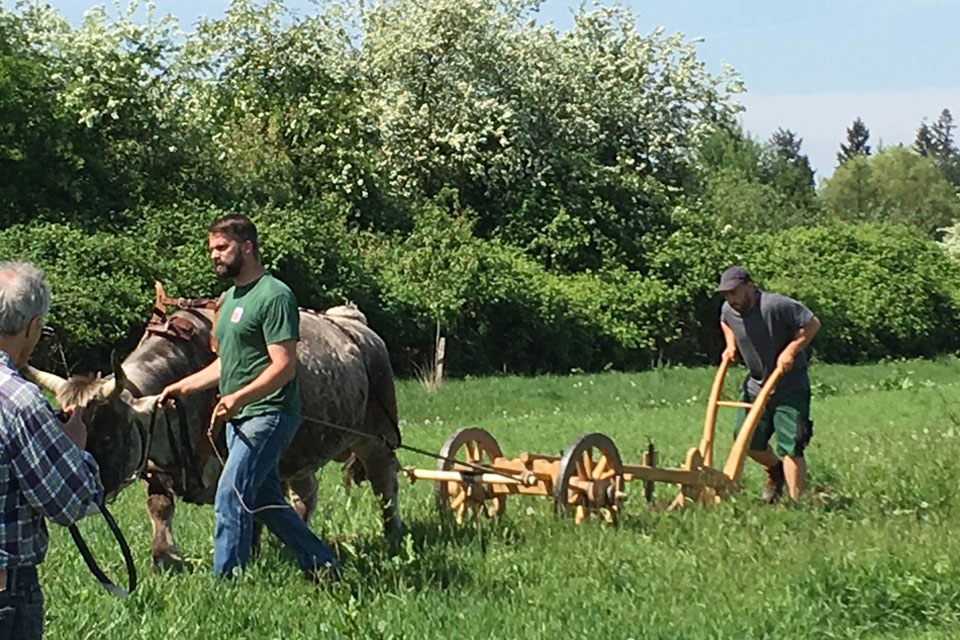How did the Carolingians work their land? At an Open-Air Museum at Lorsch in Germany, a group of people have got together to construct an ancient plough and to experiment with early medieval farming practices

Lauresham is an open-air laboratory constructed at the heart of the Lorsch Monastery in Germany. Lorsch was founded in AD 764 by one of the leading Frankish families as a manorial church, dedicated to St. Peter and St. Paul. Located east of the Rhine, it soon became one of the important Carolingian abbeys pushing Frankish dominance into the east. In 772, Charlemagne took over the Abbey which was renamed it after its main relics, the remains of St. Nazarius. Apart from the gatehouse, The Abbey, was completely destroyed during the 30-years war. Today, nothing remains but the gatehouse, now a famous Carolingian relic, which has been declared UNESCO world heritage.
Since 2012, people at Lauresham have been involved in constructing an open-air laboratory showcasing a Carolingian manor (Herrenhof). Covering 4,1 ha, it includes a series of buildings and houses including tilled gardens and fields as well as meadows and pasture. Part of the set-up is to copy the outline of a manorial farm as described in the Carolingian capitulary, De Villis. Prominent is the showcasing of ancient breeds and plants as well as the organisation of the landscape. Also, carrying out archaeological recreation and re-enactment of old crafts and technologies form an exciting part.
At a scale 1:1 model of an Early Medieval manor, Lauresham functions as a vast basis for experiments in the field of Experimental Archaeology, Agriculture and Ancient Crafts. For instance, on more than one hectare, this open-air laboratory conducts experiments on the function, advantages and disadvantages of different field systems of the Early Middle Ages, including ridges and furrows. Using (re)constructed medieval ploughs and draft cattle, it is the goal to create as authentic conditions as possible for the scientific experiments. A professional weather station, soil analysis, growth monitoring of the different crops and the calculation of the maximum draft power needed for the various agricultural implements all allow deep and new insights on the value of medieval subsistence strategies for 21st-century agriculture.
In 2019, the focus was on the reconstruction and implementation of a Carolingian plough. This project – Early Medieval ploughing implements and their detailed experimental archaeological (re)construction, use, testing and recording – is organised by Claus Kropp from Germany and Brendan O’Neill from Ireland.
These experiments have been carried out during and int in the aftermath of the drought, which characterised the summer of 2018. Thus, these experiments also serve to explore the consequences of severe or extreme climatic events in a preindustrial and premodern world. It appears the drought made the ploughing extremely heavy. Hence, the flock of pigs were invited to rough up the earth before sowing in the autumn.
Nevertheless, because of implementation of the agricultural formation of ridges and furrows, the result was less miserable than might have been expected. The seed, which landed in the furrows was nourished by the shadow and moisture provided by the ridges. Also, the combined package of various sorts of grains contributed to the overall resilience of the farming at Lauresham this year.
VISIT:
Freilichtlabor Lauresham
UNESCO Welterbe Kloster Lorsch
Nibelungenstraße 32, 64653 Lorsch
Germany
SOURCES:
Die Dürre des Jahres 2018 aus der Perspektive mittelalterlicher Subsistenzwirtschaft. Erste Erfahrungen aus dem Experimentalarchäologischen Freilichtlabor Lauresham
By Claus Kropp
Laureshamensia II, 2019
Wölbäcker. Altes Wissen neu entdecken
By Claus Kropp, Jens Schabacker and Katja Wioedner
Laureshamensia I, 2017
READ MORE:
